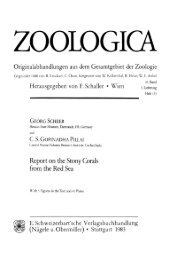observations on the egg-cases of some ovo ... - Eprints@CMFRI
observations on the egg-cases of some ovo ... - Eprints@CMFRI
observations on the egg-cases of some ovo ... - Eprints@CMFRI
You also want an ePaper? Increase the reach of your titles
YUMPU automatically turns print PDFs into web optimized ePapers that Google loves.
760 JOURNAL, BOMBAY NATURAL HIST. SOCIETY, Vol. 49<br />
after <strong>the</strong> entry <strong>of</strong> <strong>the</strong> <strong>egg</strong> in <strong>the</strong> partially formed <strong>egg</strong>-case,' regarding<br />
<strong>the</strong> formati<strong>on</strong> <strong>of</strong> <strong>the</strong> <strong>egg</strong>-case in oviparous forms.'<br />
The above-menti<strong>on</strong>ed <str<strong>on</strong>g>observati<strong>on</strong>s</str<strong>on</strong>g> have all been restricted to<br />
oviparous forms. The c<strong>on</strong>diti<strong>on</strong> <strong>of</strong> <strong>the</strong> <strong>egg</strong>-case in <strong>the</strong> <strong>ovo</strong>-viviparous<br />
forms such as Rhinobatus granulatus, Rhynchobatus djiddensis and<br />
Pristis cuspidatus suggest <strong>the</strong> improbability <strong>of</strong> <strong>the</strong> <strong>egg</strong>-case being<br />
formed after <strong>the</strong> <strong>egg</strong> reaches <strong>the</strong> nidamental gland. The mode <strong>of</strong><br />
formati<strong>on</strong> <strong>of</strong> <strong>the</strong> <strong>egg</strong>-case, which <strong>the</strong> author believes to be <strong>of</strong> general<br />
occurrence in Elasmobranclis, would seem applicable to all forms.<br />
In all <strong>the</strong> <strong>ovo</strong>-viviparous species described, a single <strong>egg</strong>-case covers<br />
more than <strong>on</strong>e <strong>egg</strong>. Usually <strong>the</strong> number varies from three to five.<br />
This arrangement stood against <strong>the</strong> acceptance <strong>of</strong> <strong>the</strong> view that <strong>the</strong><br />
<strong>egg</strong>-case is being secreted around <strong>the</strong> <strong>egg</strong> or <strong>egg</strong>s after <strong>the</strong>y reach<br />
<strong>the</strong> nidamental gland. If, according to Borcea (19o4), <strong>on</strong>e <strong>egg</strong> in<br />
<strong>the</strong> nidamental gland can give so much pressure as to prevent <strong>the</strong><br />
secreti<strong>on</strong>s from flowing out, what will be <strong>the</strong> pressure exerted <strong>on</strong> <strong>the</strong><br />
gland by three to five large ova each measuring about 5o mm. in<br />
diameter?<br />
Most <strong>of</strong> <strong>the</strong> previous workers agree that <strong>the</strong> formati<strong>on</strong> <strong>of</strong> <strong>the</strong><br />
shell commences before <strong>the</strong> <strong>egg</strong> reaches <strong>the</strong> gland. It has been<br />
doubted whe<strong>the</strong>r normal <strong>egg</strong>-<strong>cases</strong> can be formed, c<strong>on</strong>sidering i he<br />
highly sticky nature <strong>of</strong> <strong>the</strong> secreti<strong>on</strong>s, when <strong>the</strong>re is no <strong>egg</strong> in <strong>the</strong><br />
nidamental gland to keep its walls separate and to prevent <strong>the</strong> walls<br />
<strong>of</strong> <strong>the</strong> <strong>egg</strong>-case from collapsing (Nalini, 194o). The <str<strong>on</strong>g>observati<strong>on</strong>s</str<strong>on</strong>g> <strong>of</strong><br />
Beard (189o) show that about ten per cent <strong>of</strong> <strong>some</strong> shark <strong>egg</strong>-<strong>cases</strong><br />
laid in captivity were found to c<strong>on</strong>tain no <strong>egg</strong>. More instances <strong>of</strong><br />
such <strong>egg</strong>-<strong>cases</strong>, c<strong>on</strong>taining no <strong>egg</strong>, have been recorded by Borcea<br />
(194, Metten (1939), Gudger (194o) and Smith (1942). These records<br />
substantiate <strong>the</strong> fact that <strong>the</strong> walls <strong>of</strong> <strong>the</strong> <strong>egg</strong>-case can remain separate<br />
even though <strong>the</strong>re is no <strong>egg</strong> in between. Fur<strong>the</strong>r, it is not unlikely<br />
that a certain quantity <strong>of</strong> albumen will be secreted into <strong>the</strong> <strong>egg</strong>case<br />
that is in <strong>the</strong> process <strong>of</strong> formati<strong>on</strong> and this will keep <strong>the</strong> walls<br />
from collapsing. As Metten (1940) has remarked <strong>some</strong> <strong>egg</strong>-<strong>cases</strong>,<br />
even though <strong>the</strong>y do not c<strong>on</strong>tain <strong>the</strong> <strong>egg</strong>s, have albumen inside.<br />
Externally, <strong>the</strong>se 'empty <strong>egg</strong>-<strong>cases</strong>', it is reported, are quite indistinguishable<br />
from o<strong>the</strong>rs, except for <strong>the</strong>ir lighter weight. Such empty<br />
<strong>egg</strong>-<strong>cases</strong> are <strong>some</strong>times known as 'wind <strong>egg</strong>s'.<br />
In a mature female specimen <strong>of</strong> Galeocerdo tigrinus, caught <strong>of</strong>f<br />
<strong>the</strong> Madras Coast <strong>on</strong> August to, 1944 measuring 3775 mm. in length,<br />
two <strong>egg</strong>s, <strong>on</strong>e in each cranial oviduct, were seen migrating down into<br />
<strong>the</strong> nidamental glands. They had already travelled about <strong>on</strong>e-third<br />
<strong>of</strong> <strong>the</strong> distance from <strong>the</strong> oviducal funnel to <strong>the</strong> nidamental gland.<br />
An examinati<strong>on</strong> <strong>of</strong> <strong>the</strong>se glands revealed that <strong>the</strong>y had already begun<br />
to secrete <strong>the</strong> <strong>egg</strong>-case and part <strong>of</strong> <strong>the</strong> <strong>egg</strong>-case formed could be<br />
traced from <strong>the</strong> lateral horns <strong>of</strong> <strong>the</strong> gland to <strong>the</strong> caudal oviduct. The<br />
porti<strong>on</strong> that had already been formed would evidently c<strong>on</strong>stitute <strong>the</strong><br />
highly c<strong>on</strong> - Tressed and twisted cord at <strong>on</strong>e pole <strong>of</strong> <strong>the</strong> <strong>egg</strong>-case.<br />
The very fact that <strong>on</strong>e seldom encounters a partly formed <strong>egg</strong>-case<br />
as <strong>the</strong> <strong>on</strong>e menti<strong>on</strong>ed here, suggests that <strong>the</strong> formati<strong>on</strong> <strong>of</strong> <strong>the</strong> <strong>egg</strong>case<br />
is ra<strong>the</strong>r quick and hence it is <strong>on</strong>ly by pure chance that <strong>on</strong>e<br />
1 6 1<br />
Note : Italics by author.
















